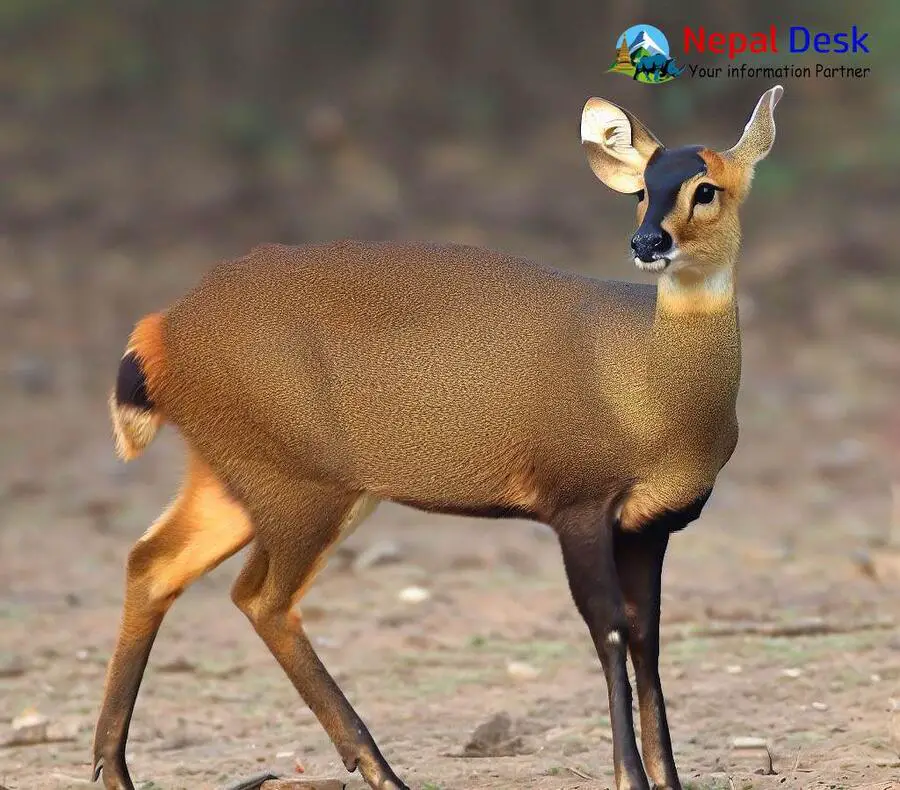
The Alpine Musk Deer, scientifically known as Moschus chrysogaster, is a small and fascinating mammal that makes its home in Nepal's Himalayan region. Boasting a one-of-a-kind appearance, this little deer's dark brown coat transforms to gray during the winter months. It also sports distinctive fang-like canine teeth. Interestingly, male Alpine Musk Deer are bigger than females, growing up to 80 cm tall at the shoulder and weighing a maximum of 25 kg.
These captivating creatures are known for their timid and elusive behavior, making it quite challenging to spot them out in the wild. They are most active during daylight hours and twilight, opting to reside in thick forests and rugged, rocky landscapes at soaring altitudes—often even above the treeline.
The Alpine Musk Deer has a unique glandular sac situated between its naval and genital areas, which produces a valuable musky scent used for marking territory and luring mates. This scent is highly sought after in the perfume industry, regrettably leading to illegal hunting and poaching of these animals.
When it comes to their diet, Alpine Musk Deer are herbivores that primarily feast on lichens, mosses, grasses, and leaves from shrubs and trees. During wintertime, they also consume various fungi and tree bark.
These deer breed throughout the year with peak breeding taking place during winter months. After a gestation period of roughly 180 days, females usually give birth to just one fawn adorned with white spots—helpful camouflage against potential predators.
Sadly, the Alpine Musk Deer is categorized as endangered on the IUCN Red List due to factors such as habitat loss, hunting, and poaching. In Nepal, they receive protection under the National Parks and Wildlife Conservation Act within protected areas like Langtang National Park and Sagarmatha National Park. Nevertheless, their population continues to dwindle despite conservation efforts—further stressing the importance of taking additional steps to ensure their survival in the wild.
Native to various regions in Nepal, the Alpine Musk Deer favors steep, rocky landscapes at high elevations typically above the treeline. They nourish themselves on an array of plants and shrubs, mostly remaining solitary except during mating season when males may group together.
These selective feeders incorporate numerous plants and shrubs into their diet, including lichens, mosses, grasses, and deciduous tree leaves. In search of the perfect meal, they may traverse great distances.
Alpine Musk Deer mate from October through December, with females giving birth to a sole fawn after a six-month gestation period. The fawn remains with its mother for around six to eight months before gaining independence.
Belonging to the Moschidae family and classified within the Moschus genus, the Alpine Musk Deer is a small but sturdy animal possessing a unique humped appearance and sizeable hoof-like claws on its hind legs. Males have lengthy, curved canine teeth or tusks used for display and competition during the breeding season.
Unfortunately, this intriguing mammal is endangered due to habitat loss, hunting, and illegal musk gland trade used in traditional medicine and perfume production. Thankfully, in Nepal, efforts are being made under the National Parks and Wildlife Conservation Act to preserve its habitat and combat poaching.
Deep within the heart of Nepal, the Alpine Musk Deer holds a cherished position not only in the ecosystem but also in the region's cultural fabric. Locals often exchange stories and myths about this enigmatic creature, incorporating it into their rich heritage. But life in the wilderness presents many challenges. The presence of predators such as snow leopards and wolves makes the fawn's white spots essential for survival.
While the musk is beneficial to the deer in attracting partners, it has unintentionally put their existence at risk. The musk draws attention due to its economic value, particularly in regions where the perfume industry prospers, resulting in increased poaching. Nevertheless, the disappearance of these animals could negatively affect local economies, especially where eco-tourism is an attraction.
The bond between Alpine Musk Deer and local communities is complex. Some people revere them as sacred beings, while others view them as a resource. This ambivalence intensifies the necessity for conservation initiatives.
Ongoing research and studies on Alpine Musk Deer aim to comprehend their behavior, habitat requirements, and genetic diversity. Such endeavors emphasize their significance not only as a species but also as an integral part of the Himalayan ecosystem.
For adventurers at heart, spotting an Alpine Musk Deer presents an enthralling opportunity. The deer's existence enhances wildlife tourism, attracting enthusiasts and photographers seeking that elusive sighting. By practicing responsible tourism, we can support conservation efforts and help shift the odds in favor of these deer.
The Alpine Musk Deer's tale exemplifies both nature's marvels and fragility. As they face adversity in their wild environment, it falls on us to ensure their continued existence and contribution to Nepal's enchanting Himalayan landscape.
